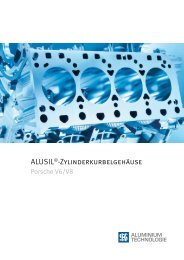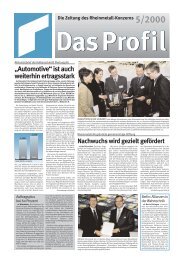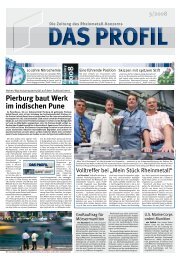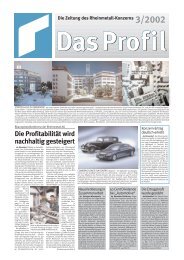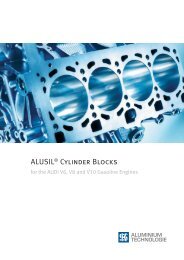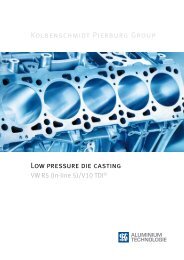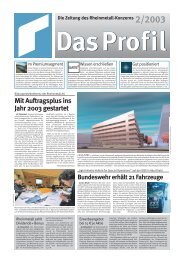Annual Report 2001 - KSPG AG
Annual Report 2001 - KSPG AG
Annual Report 2001 - KSPG AG
You also want an ePaper? Increase the reach of your titles
YUMPU automatically turns print PDFs into web optimized ePapers that Google loves.
Kolbenschmidt Pierburg <strong>AG</strong><br />
Executive Board report<br />
Management report on the Kolbenschmidt Pierburg Group<br />
<strong>Report</strong>ing format<br />
This report on <strong>2001</strong> is the first annual<br />
report the Kolbenschmidt Pierburg<br />
Group has prepared in accordance with<br />
the IASB’s International Accounting<br />
Standards (IAS). To ensure a meaningful<br />
comparison, the prior-year data<br />
(in 2000 still based on the German<br />
Commercial Code, or “HGB”) was<br />
subsequently restated to conform to<br />
IAS and contrasted to the IAS-based<br />
disclosures for fiscal <strong>2001</strong>.<br />
Kolbenschmidt Pierburg <strong>AG</strong>’s<br />
Executive Board<br />
Dr. Gerd Kleinert<br />
The changeover to IAS as primary<br />
accounting basis meant that three<br />
special-purpose property companies<br />
had to be additionally included in the<br />
consolidation group as of December<br />
31, 2000 as well as <strong>2001</strong>.<br />
Set up as of April 1, <strong>2001</strong>, together<br />
with SAIC, one of China's biggest<br />
automotive companies, the joint<br />
venture Kolbenschmidt Pierburg<br />
Shanghai Nonferrous Components<br />
Co. Ltd. (KPSNC), Shanghai, China,<br />
has been included at equity in the<br />
Air Supply & Pumps division.<br />
MotorEngineering is a division operating<br />
in the market for exhaust gas,<br />
flowmeter and workshop measuring<br />
equipment for developing and servicing<br />
I.C. engines and accounts for a<br />
mere 2 percent of the Group’s annual<br />
sales. Thus, it is not eligible for inclusion<br />
as one of the Kolbenschmidt<br />
Pierburg Group’s core businesses<br />
and therefore effective the turn of<br />
<strong>2001</strong>/2002, AVL Holding GmbH, Graz,<br />
Austria, as part of a joint venture<br />
agreement, has taken over a majority<br />
stake in the division’s parent company<br />
Pierburg Instruments GmbH, in which<br />
it is also exercising industrial management.<br />
While this company’s income<br />
statement is reflected in Kolbenschmidt<br />
Pierburg <strong>AG</strong>’s consolidated<br />
financial statements, its balance sheet<br />
as of December 31, <strong>2001</strong>, is not. In<br />
future, this company will be included<br />
at equity. Additionally, the 100-percent<br />
stake held in Pierburg Instruments Inc.,<br />
Auburn Hills, Michigan, USA, a company<br />
serving the American market with<br />
the development, manufacture, and<br />
marketing of flowmeter and exhaust<br />
gas measuring equipment, was deconsolidated<br />
and sold as of January 1,<br />
<strong>2001</strong>, to AVL Michigan Holding Inc.,<br />
Plymouth, Michigan, USA.<br />
As of January 1, <strong>2001</strong>, Vehicle Spares<br />
Ltd., Dublin, Ireland, was sold and<br />
likewise deconsolidated.<br />
Regarding changes in the consolidation<br />
group, the comparative figures<br />
for the past two years are those certified<br />
in the annual accounts; due to<br />
the marginal significance of such<br />
changes, a comparable restatement<br />
has been waived.<br />
Dr. W. Hans Engelskirchen Dr. Jörg-Martin Friedrich Georg Liebler Dr. Peter Merten<br />
12 13<br />
Business trend<br />
Fiscal <strong>2001</strong> for Kolbenschmidt Pierburg<br />
was overclouded by the worsening<br />
economic conditions in the course of<br />
the year. Nonetheless, most of the<br />
Group’s companies successfully upheld<br />
their position in the markets, the<br />
consequence being that Group sales<br />
gained by 2.8 percent to €1,825.5<br />
million. Five of the six divisions played<br />
their part in improving sales revenues<br />
over the previous year. The growth<br />
regions in <strong>2001</strong> were Western Europe<br />
and South America, whereas the<br />
Group’s activities in North America<br />
suffered from reduced customer calloffs<br />
and project postponements.<br />
World production down<br />
Passenger car production by<br />
selected regions<br />
(million units)<br />
Following the upswing of 2000, auto<br />
and LCV production in Asia in <strong>2001</strong><br />
re-declined (down 1.7 percent). It was<br />
particularly in the volume markets of<br />
Japan and South Korea that car production<br />
fell by 2.1 and 3.4 percent,<br />
respectively. LCV production in these<br />
countries also dropped, by 6.0 and<br />
1.7 percent, respectively. In contrast<br />
and although from a relatively low<br />
baseline, car production in China<br />
again revved up, by 28.1 percent to<br />
0.7 million units. Including the LCVs,<br />
which account for a major slice of<br />
automotive output in China, production<br />
added up to 1.8 million units (up<br />
10.4 percent).<br />
On the basis of the existing projections,<br />
world production of autos and<br />
light commercial vehicles (LCVs, under<br />
3.5 t) in <strong>2001</strong> dropped by 3.1 percent<br />
to 53.6 million, of which automobiles<br />
accounted for 39.8 million (down 2.3<br />
percent) and LCVs for 13.8 million<br />
(down 5.5 percent). A major problem<br />
for the carmakers is the declining<br />
sales in major world markets (NAFTA,<br />
Japan), which are hardly retrievable<br />
elsewhere.<br />
Within NAFTA, the United States produced<br />
much fewer autos (around 4.9<br />
million, down 11.9 percent) and LCVs<br />
(around 6.3 million, down 9.0 percent)<br />
than back in 2000, even though the<br />
final quarter of the period saw a number<br />
of special campaigns such as zerointerest<br />
financing, cash incentives,<br />
and early re-leasing options, which<br />
together did help prop up sales,<br />
Western/Eastern Europe<br />
2000<br />
<strong>2001</strong> (provisional)<br />
NAFTA<br />
Asia incl. Japan<br />
8.4<br />
7.4<br />
Western Europe in <strong>2001</strong> again showed<br />
a slight gain in the production of cars<br />
and LCVs, this time by 1.4 percent to<br />
16.8 million units. Whereas France<br />
and Germany boosted production to<br />
just over 3.5 million vehicles (up 7.8<br />
percent) and 5.2 million (up 3.5 percent),<br />
respectively, output in Italy fell<br />
to a good 1.5 million units (down 9.5<br />
percent) as in Spain to just under 2.9<br />
million units (down 1.9 percent) and<br />
Britain to just under 1.7 million units<br />
(down 7.1 percent). In Germany, exports<br />
rose by 5 percent to a good 3.6 million<br />
units. In contrast, the number of newly<br />
registered vehicles fell by 1.4 percent<br />
in Western Europe. The number of<br />
foreign makes registered declined by<br />
though at the expense of severely<br />
eroded earnings. Production figures<br />
in Canada slumped too, cars falling to<br />
1.3 million units (down 17.2 percent)<br />
and LCVs to 1.2 million (down 8.4 percent).<br />
In South America, the number of cars<br />
and LCVs produced gained by 1.9 percent<br />
to around 1.9 million units. Whereas<br />
production in Brazil advanced by<br />
over 8 percent, the figure for Argentina<br />
crumbled by almost 31 percent due to<br />
that nation’s economic woes.<br />
–11.9%<br />
Sales growth<br />
despite<br />
tough conditions<br />
13.1<br />
12.9<br />
–1.5%<br />
17.2<br />
17.4 +1.2%<br />
6 percent whereas German brands<br />
gained by almost 1 percent.<br />
Diesel engines<br />
advancing<br />
Diesel engine cars and station wagons<br />
once more progressed in the markets<br />
of Western Europe, particularly those<br />
of the mass producers Volkswagen,<br />
PSA, and Renault, which offer a large<br />
number of diesel engines. In Germany<br />
and France, the proportion of such<br />
vehicles as a percentage of car and<br />
station wagon production, rose by<br />
almost 4 percent to some 38 and 41<br />
percent, respectively.


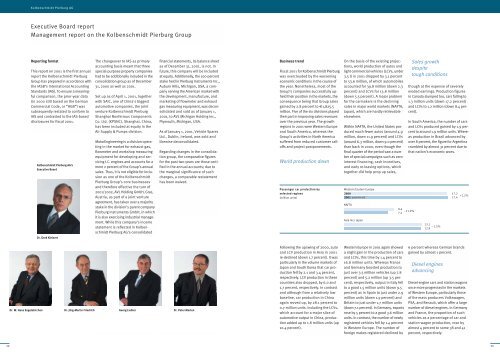
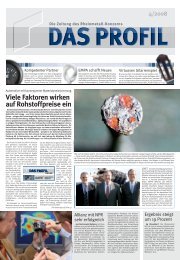
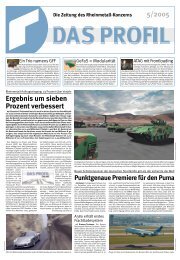
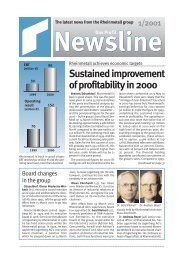
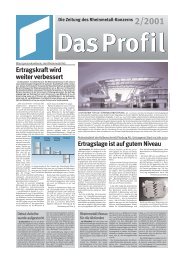
![PDF [1.0 MB] - KSPG AG](https://img.yumpu.com/5513074/1/171x260/pdf-10-mb-kspg-ag.jpg?quality=85)
